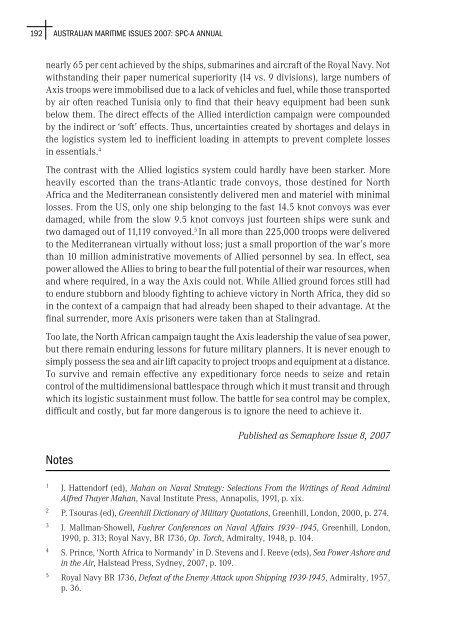Australian Maritime Issues 2007 - Royal Australian Navy
Australian Maritime Issues 2007 - Royal Australian Navy
Australian Maritime Issues 2007 - Royal Australian Navy
You also want an ePaper? Increase the reach of your titles
YUMPU automatically turns print PDFs into web optimized ePapers that Google loves.
192 AUSTRALIAN MARITIME ISSUES <strong>2007</strong>: SPC-A ANNUAL<br />
nearly 65 per cent achieved by the ships, submarines and aircraft of the <strong>Royal</strong> <strong>Navy</strong>. Not<br />
withstanding their paper numerical superiority (14 vs. 9 divisions), large numbers of<br />
Axis troops were immobilised due to a lack of vehicles and fuel, while those transported<br />
by air often reached Tunisia only to find that their heavy equipment had been sunk<br />
below them. The direct effects of the Allied interdiction campaign were compounded<br />
by the indirect or ‘soft’ effects. Thus, uncertainties created by shortages and delays in<br />
the logistics system led to inefficient loading in attempts to prevent complete losses<br />
in essentials. 4<br />
The contrast with the Allied logistics system could hardly have been starker. More<br />
heavily escorted than the trans-Atlantic trade convoys, those destined for North<br />
Africa and the Mediterranean consistently delivered men and materiel with minimal<br />
losses. From the US, only one ship belonging to the fast 14.5 knot convoys was ever<br />
damaged, while from the slow 9.5 knot convoys just fourteen ships were sunk and<br />
two damaged out of 11,119 convoyed. 5 In all more than 225,000 troops were delivered<br />
to the Mediterranean virtually without loss; just a small proportion of the war’s more<br />
than 10 million administrative movements of Allied personnel by sea. In effect, sea<br />
power allowed the Allies to bring to bear the full potential of their war resources, when<br />
and where required, in a way the Axis could not. While Allied ground forces still had<br />
to endure stubborn and bloody fighting to achieve victory in North Africa, they did so<br />
in the context of a campaign that had already been shaped to their advantage. At the<br />
final surrender, more Axis prisoners were taken than at Stalingrad.<br />
Too late, the North African campaign taught the Axis leadership the value of sea power,<br />
but there remain enduring lessons for future military planners. It is never enough to<br />
simply possess the sea and air lift capacity to project troops and equipment at a distance.<br />
To survive and remain effective any expeditionary force needs to seize and retain<br />
control of the multidimensional battlespace through which it must transit and through<br />
which its logistic sustainment must follow. The battle for sea control may be complex,<br />
difficult and costly, but far more dangerous is to ignore the need to achieve it.<br />
Notes<br />
Published as Semaphore Issue 8, <strong>2007</strong><br />
1<br />
J. Hattendorf (ed), Mahan on Naval Strategy: Selections From the Writings of Read Admiral<br />
Alfred Thayer Mahan, Naval Institute Press, Annapolis, 1991, p. xix.<br />
2<br />
P. Tsouras (ed), Greenhill Dictionary of Military Quotations, Greenhill, London, 2000, p. 274.<br />
3<br />
J. Mallman-Showell, Fuehrer Conferences on Naval Affairs 1939–1945, Greenhill, London,<br />
1990, p. 313; <strong>Royal</strong> <strong>Navy</strong>, BR 1736, Op. Torch, Admiralty, 1948, p. 104.<br />
4<br />
S. Prince, ‘North Africa to Normandy’ in D. Stevens and J. Reeve (eds), Sea Power Ashore and<br />
in the Air, Halstead Press, Sydney, <strong>2007</strong>, p. 109.<br />
5<br />
<strong>Royal</strong> <strong>Navy</strong> BR 1736, Defeat of the Enemy Attack upon Shipping 1939-1945, Admiralty, 1957,<br />
p. 36.
















